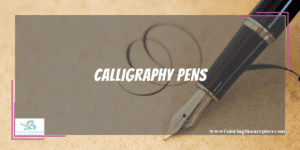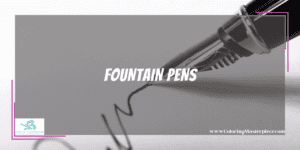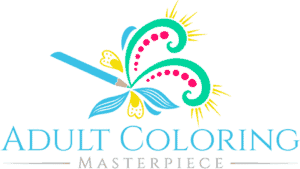To understand which would be better, a fountain pen or a calligraphy pen, it is first essential to understand the nature of these writing tools. Although both have their root antecedents in the reed or quill pen, each has unique properties. As with many art supplies or writing supplies, a fountain pen vs. a calligraphy pen, which is best, depends largely on the work at hand.
Calligraphy Pens

These pens are primarily a holder and a steel pen nib. These nibs usually have a certain amount of flex to them, which gives the calligraphy strokes their unique attributes. These attributes are a broad line on the downstroke and a thin line on the upstroke or side sweep. A calligraphy pen can never be pushed directly upward in the same manner as a pencil, felt-tipped pen, or ballpoint pen, because this would dig the point of the pen into the paper. Calligraphy pens usually use ink that has a heavy viscosity so it will stick to the pen better, and this also affects the results.
The art of calligraphy is frequently used when illuminating manuscripts, designing wall hangings, or creating a special message to be shared with a group. There are a variety of styles of calligraphy ranging from Old English to Modern. Each has its unique characteristics. Spencerian is possibly one of the most ornate, while copperplate was developed so that it could be engraved on copper panels, inked, and stamped on paper.
Fountain Pens

This is the most immediate descendant of the calligraphy or stick pen. It uses a similar point but because it is designed to last a long while, it uses a higher quality steel which usually has less flexibility. Like the calligraphy pen, it writes best by using a down pull plus side sweep motion rather than pushing the pen directly upward. With that said, because of its stiffer nib, it writes differently from a stick pen. It can be used for some styles of calligraphy, but not the more ornate scripts. However, on the other hand, it allows a freer flow of thought while using one to write generally because it does not require frequent dipping. The reservoir allows the user to write several paragraphs (with some models several pages) before refilling. Because a fountain pen has a reservoir and the ink must flow from it, it will use a thinner ink than a calligraphy pen.
These pens were invented more or less as a convenience. You could write longer with them, apply less pressure, and the ink from them flowed easily across the page and (because it was thinner) dried more quickly with less smudging. It is said that the very first fountain pen was invented because a pharaoh of Egypt wanted a writing tool that would not smudge his fingers.
Furthermore, a fountain pen was more portable than a stick pen, with several nibs, and a bottle of ink. The writing was still beautiful and had a permanence similar to that of the writing done using a calligraphy pen. It would not fade in the way that a lead or charcoal pencil would fade and did not have to be sharpened to gain a fine point.
Some sources suggest that fountain pens even have an advantage over ballpoint pens, their modern successor, and they certainly have advantages over felt-tipped pens. Ballpoint pens require pressure to encourage the ball to roll and distribute the ink. Felt-tipped pens work best if no pressure is applied, but the felt tip can be easily damaged by users who think pressing harder will promote a darker line. In addition, most of them have a limited use-life because they will either run out of ink or the ink will dry up. Although, a few models of felt-tipped pens are refillable. The advantage of ballpoint or felt-tipped pens over either a stick (calligraphy) pen or a fountain pen is that they can be used with an upward push in the same manner as a pencil. Plus, they are even more portable than a fountain pen and are usually less likely to leak.
By way of contrast to more modern ink writing tools, a fountain pen – by its very nature – is always refillable. A few of them even have interchangeable points that allow them to mimic the nibs on a stick pen, otherwise known as a calligraphy pen. This makes them a versatile tool for writing important letters, creating ornate cards, signing books, or writing special package labels.
But let us not discount the flexible nibs that can be attached to a pen stick. First, the nibs are available in a variety of styles and points ranging from the very finest sharp point – which is usually split up the center to a loophole approximately the same size as the head on a dressmaker’s straight pen, to a broad nib with has slots at the bottom of a folded piece of metal that encompasses a wavy metal piece designed to help the nib hold more ink. The fine nibs are excellent for delicate writing, such as Spencerian, as well as inked artwork such as hatching and cross-hatching. Specialized paddle-shaped nibs produce wider lines than the writing nibs, and the wide nibs are excellent for producing lettering on posters.
As you can readily see from this brief comparison, whether a calligraphy pen or a fountain pen is the best choice for you depends a great deal on which pen, made by whom, for what purpose; and upon the kind of project for which you need the pen. In a few cases, more modern tools such as ballpoint pens or felt-tipped markers will be a better choice.
Note: While ink designed for fountain pens can be used with a calligraphy pen, the reverse is not true. The thicker calligraphy ink will clog a fountain pen and quickly ruin it.
What about brush pen calligraphy? We’ve got more information here!
Maximize the benefits of coloring with my free adult coloring eBook and by signing up for my email newsletter HERE!
Disclaimer: The information provided by ColoringMasterpiece.com (“The Site”) is for general informational purposes only. All information on the Site is provided in good faith, however, we make no representation or warranty of any kind, express or implied, regarding the accuracy, adequacy, validity, reliability, availability, or completeness of any information on the Site. Under no circumstance shall we have any liability to you for any loss or damage of any kind incurred as a result of the use of the Site or Reliance on any information provided on the Site. Your use of the Site and your reliance on any information on the Site is solely at your own risk. This blog post is for educational purposes only and does not constitute legal advice. Please consult a legal expert to address your specific needs.
Terms and Conditions: https://coloringmasterpiece.com/terms-and-conditions/
